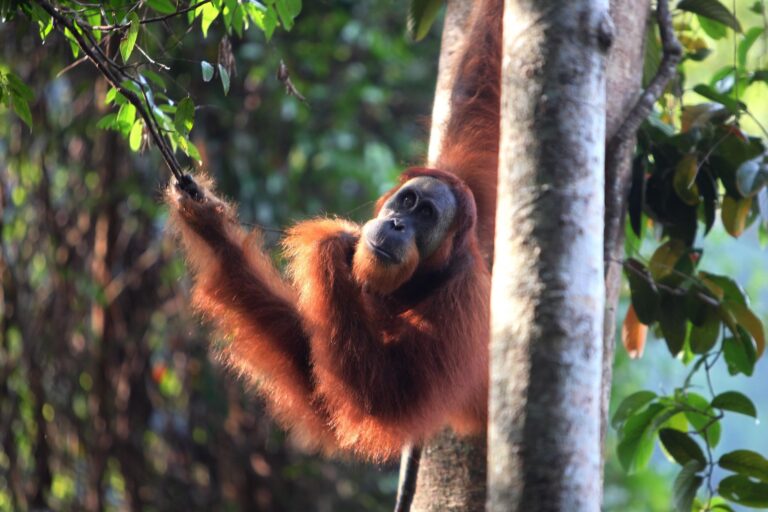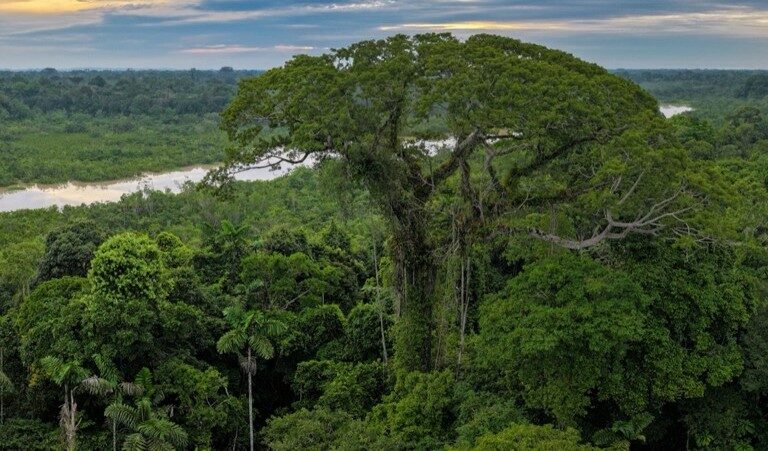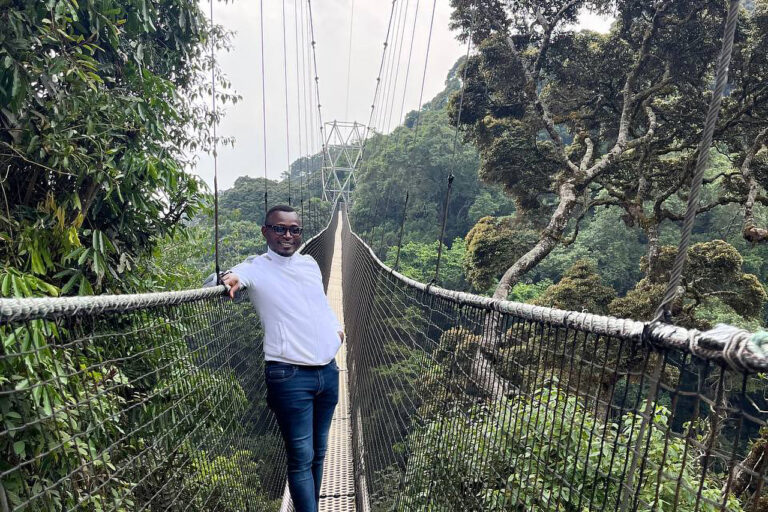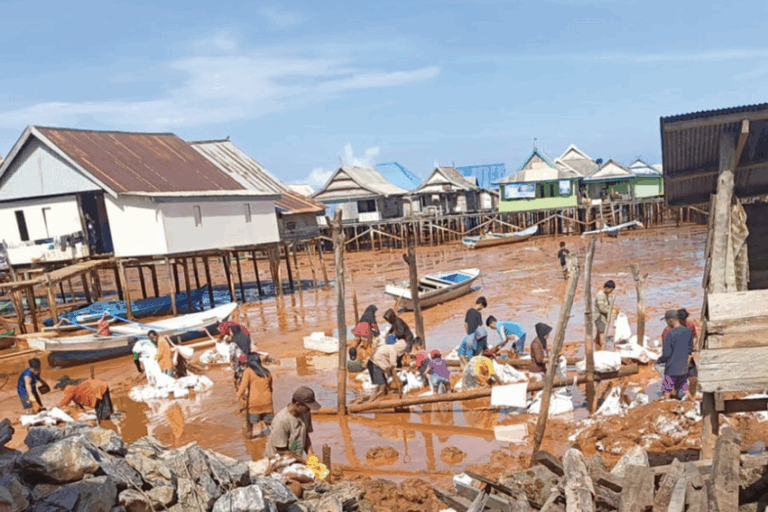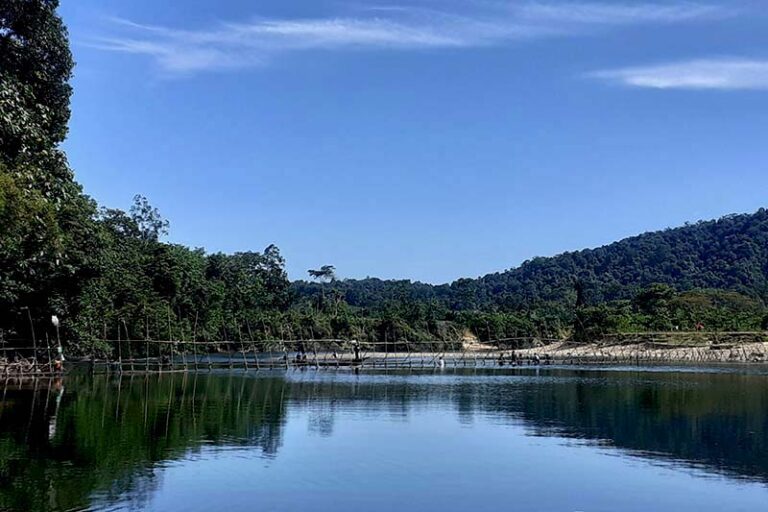- In Indonesia’s Central Kalimantan province, Indigenous Dayak societies living in Pulang Pisau district received a lease from the central government to manage a peatland under Indonesia’s acclaimed social forestry program.
- However, that management license required the Indigenous communities to establish a new state institution at the village level to implement national laws governing forests.
- This form of governance clashed in part with a traditional configuration that the Dayak have practiced for generations, known as handil after the canals running alongside growing areas.
- Local civil society organizations have stepped in to close this gap to support the community blend state laws with traditional norms and other longstanding cultural practices.
PULANG PISAU, Indonesia — Bandi paddled through the black swamp, passing alongside banks of high brush outside Kalawa village here in the south of Borneo Island. The narrow canoe, known here as a ces, arrowed through the water, leaving a low ripple in its wake.
“Since there’s been community forestry here, we can now protect the forest,” Bandi said as he traversed the peatland. “We look after the forests surrounding our village — they don’t burn.”
A national drive to convert some 1 million hectares (2.5 million acres) of peatland into rice fields by then-president Suharto clear-cut a vast tract of Bornean rainforest in the 1990s, which many Indigenous Dayak considered to be a violation of customary rules.
The project became a notorious environmental catastrophe. Much of the land alongside the Sebangau, Kahayan, Kapuas, Kapus Murung and Barito rivers was destroyed by fire. The aftermath left the landscape prone to floods in monsoon seasons and wildfires during droughts, seasonal patterns now aggravated by climate change.
A decade ago the entire landscape was also ablaze here in Pulang Pisau, a district in Indonesia’s Central Kalimantan province. In mid-2015, toxic wildfire smoke seeped under doors of Dayak longhouses, through the cracks in the timber frame, and past the blood-brain barrier of the people sheltering inside.
The haze hung over most of Borneo for months as the fires spread across the peat. Around 2.6 million hectares (6.4 million acres) burned across the country during that year’s dry season.
The catastrophe will have likely caused tens of thousands of premature deaths in Indonesia due to the pollution. In response, President Joko Widodo vowed to reform the land-use sector, which included bans on peatland development and accelerated devolution of land management to local communities.
The Indonesian government intends to release a total of 13 million hectares (32 million acres) from the national forest estate for leasehold management by local communities, a policy known as social forestry. Data from the Ministry of Environment and Forestry showed the state had released 6.1 million hectares (15.1 million acres) to community-managed leases by end-September 2023.
A number of problems afflicted farming families before the community became the leaseholder here in Pulang Pisau.
Dayak families like Bandi’s have gathered nontimber products like latex and rattan from the forest for generations. However, when this forest became the property of the state, legal jeopardy ensued as community access to land entered a gray area.

Handil with care
Prior to the community forestry license, people’s relationship with the land was determined by an Indigenous Dayak system of customary rules and norms, known here as handil. Handil refers to the canals cut through peat swamps to drain off enough water to enable agriculture. Families cultivated crops and tapped rubber trees planted in fields on either side of the handil.
Under the local customary law, the extent of the land that can be cultivated is defined by sound.
Anthropologist Robert Siburian wrote in a paper titled “Forest resource management based on traditional ecological knowledge” that the Dayak Ngaju people enforced a maximum boundary determined by how far the sound of a gong travels. In effect, the limit is usually 5 kilometers (3 miles) from the banks of a handil.
However, for the Dayak living in this landscape, the network of waterways is also a political framework under which the land is administered. The handil are the means of access to land via canoes, and they demarcate family land. Handil are both a firebreak and the primary source of irrigation.
The arrival of forestry and land laws after Indonesia declared independence in 1945 introduced a clash with these Indigenous systems of administration, which are handed down among families and spiritual elders through oral tradition.
“In Pulang Pisau, the community already had a handil customary system, while social forestry has created a new system, namely the LPHD,” said Mohammad Djauhari, director of the Community Forest System Support Consortium (KPSHK), a civil society organization.
Obtaining the government license required the village to form a forest management institution, known as an LPHD. The LPHD regulates how forests are managed at the village level based on national laws and regulations. It also oversees implementation of top-down measures designed by the central government to raise productivity, which can introduce complexity.
“This often becomes a conflict in the field, between government and traditional organizations,” said Djauhari, whose organization has supported four Dayak village forests (Kalawa, Mentaren I, Buntoi and Gohong) since 2014.
Djauhari said there were 21 of these handil canals across the four villages assisted by his organization. Each handil has an executive tasked with managing irrigation, monitoring harvest yields and resolving any conflicts. If the head of the handil is unable to resolve a disagreement, the dispute is escalated to a mantir, a Dayak elder. The highest appellate is the damang, who will adjudicate a binding ruling on the referral.
“The handil belongs to the community together,” Darius, a mantir, told Mongabay Indonesia. “There isn’t any conflict because the person who manages the handil can share equitably, and they’re trusted by the community.”
In Kalawa village, the institutions of the state and the customary authority must now cohabit. In part, that’s because the personnel often overlap. The traditional head of the handil often takes a second job as leader of the LPHD, along with other influential community elites.
“It can’t be denied that sometimes everyone’s related,” Darius said.


Handil oneself
In response to the 2015 haze crisis, President Widodo established a national agency to rehabilitate ailing peatlands. That agency has recruited fieldworkers and nonprofit groups to aid local communities in tackling the thousands of kilometers of canals that dry out and elevate fire risks on the archipelago’s peatlands.
“We carry out the rehydrating by building canal blocks in the landholding owned by this community,” Djauhari said.
The Dayak handil leaders will survey the landscape to ensure sufficient water flows through the handil to maintain saturation of the peat.
After Djauhari’s KPSHK team began outreach in the community, fieldworkers realized the importance of variance in how canal blocks were constructed. Some needed to be opened and closed as required by local farmers like Bandi, who rely on them for transportation.
“Right now, for instance, I’m taking part in raising awareness about the construction of this canal block,” Bandi told Mongabay Indonesia. “At first we were worried that if a partition was built in the handil that we would be unable to pass.”
Productive land managed by the Dayak is configured under the kaleka tradition, which intercrops tree species.
“If you look, the local rubber plants are not like neat plantations with uniform spacing — this is actually kaleka local wisdom that has been around for generations,” Djauhari said.

Djauhari describes kaleka as a kind of ancient agroforestry configuration. Rice and vegetables are grown alongside fruit trees like mangosteen and durian.
The Dayak system of swidden agriculture relies on rotation of the community’s land bank to preclude the need for fertilizer. People till these fields until the nitrogen content in the soil is depleted, then move to a newly replenished area to plant anew, typically clearing the land with a controlled blaze. The vacated land is left to nature to replenish for a decade or so.
“The types of woody plants planted and the diversity of these plants are what we now call agroforestry,” Djauhari said.
He said he hopes the Dayak kaleka system contributes insight to sustainable land management on peat.
“Until now, forest management has been oriented toward Western forest management systems,” Djauhari said.
Banner image: Handils are the boundaries of fields as well as paths for transportation and waters to fish in. Image by Titik Kartitiani.
This story was reported by Mongabay’s Indonesia team and first published here on our Indonesian site on June 1, 2024.
This coverage was supported by the Rainforest Journalism Fund convened by the Pulitzer Center.
On a Borneo mountainside, Indigenous Dayak women hold fire and defend forest








